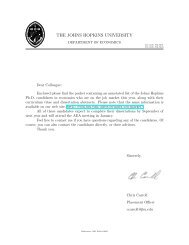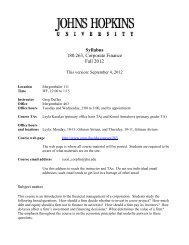WEALTH, DISPOSABLE INCOME AND CONSUMPTION - Economics
WEALTH, DISPOSABLE INCOME AND CONSUMPTION - Economics
WEALTH, DISPOSABLE INCOME AND CONSUMPTION - Economics
You also want an ePaper? Increase the reach of your titles
YUMPU automatically turns print PDFs into web optimized ePapers that Google loves.
40<br />
conventional levels. Presumably this reduced interest rate effect reflects the<br />
fact that the inclusion of wealth in the equation absorbs the wealth effect of<br />
interest rate changes, leaving only the pure substitution effect to be picked<br />
up by the coefficient on the real interest rate. The point estimates therefore<br />
suggest that most of the interest rate effect in the Keynesian equation is<br />
due to the wealth effect.<br />
Third, note that the coefficient on the first difference of the relative<br />
price of consumption is virtually unaffected by the inclusion of wealth, so<br />
while relative price effects are captured by wealth in the long run, the relative<br />
price of consumption has significant dynamic effects on consumption.<br />
Finally, the third column of Table 8 considers the impact of substituting<br />
total wealth in the cointegrating vector for human wealth and non-human<br />
wealth (excluding equity) entered separately. The impact of this substitution<br />
is relatively minor; the coefficient on the real interest rate falls marginally<br />
and there is a small dynamic effect of changes in non-human wealth.<br />
As for the Keynesian model, rolling Chow tests do not reject the null<br />
of stability for the EC equations that include wealth (see Figures 11 and 12).<br />
In addition, recursive estimates of the parameters reveal that the parameters<br />
are reasonably stable through time. Figure 13 reports recursive estimates<br />
for the model with human and non-human wealth (excluding<br />
equity) included separately, but very similar results are obtained when<br />
total wealth is used instead. Note in particular that the coefficient on the<br />
change in unemployment is now always negative, though only significantly<br />
so near the end of the sample. The residuals show little evidence of<br />
significant serial dependence, but autoregressive conditional heteroscedasticity<br />
continues to be present.




